Description
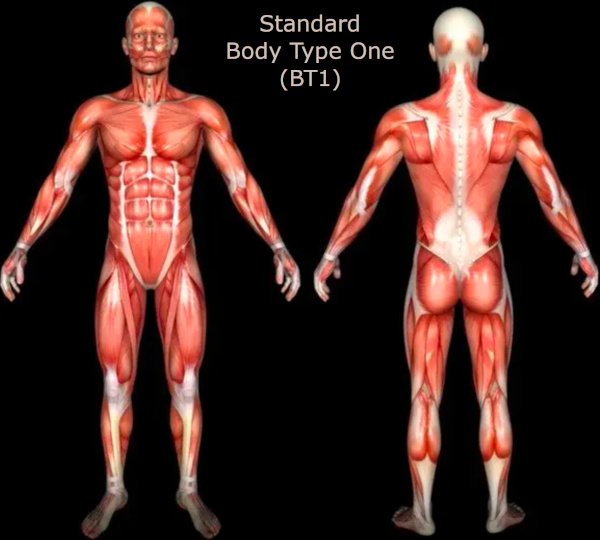 The Body Type Science Theory Research began in 2003 out of necessity. At the time, there was only the Standard Body Type One (BT1) found in any scientifically approved human body anatomy book/resource (defined and recognized by mainstream science and medical doctors). There were no other body types scientifically/medically based on real science with actual scientific definitions backed by real-world scientific data, evidence, and facts.
The Body Type Science Theory Research began in 2003 out of necessity. At the time, there was only the Standard Body Type One (BT1) found in any scientifically approved human body anatomy book/resource (defined and recognized by mainstream science and medical doctors). There were no other body types scientifically/medically based on real science with actual scientific definitions backed by real-world scientific data, evidence, and facts.
And, thus, no way to scientifically explain the countless human body shapes worldwide.
What is the Scientific/Medical Definition of Skinny Fat?
 According to the first-ever 2016 NIH definition for normal-weight obesity (skinny fat), skinny fat is defined as having too much body fat (regular white/yellow fat) when within safe Standard BMI (18.5 to 24.99). However, according to The Standard BMI definition, once you are within safe Standard BMI you no longer have any excess regular white/yellow body fat (common adipose tissue, body fat %) on your body. Being normal-weight obese/skinny fat directly contradicts and violates The Standard BMI definition and is technically impossible. The last time The Standard BMI was officially changed was in 1998 — it has not been changed since that initial 2016 NIH skinny fat definition.
According to the first-ever 2016 NIH definition for normal-weight obesity (skinny fat), skinny fat is defined as having too much body fat (regular white/yellow fat) when within safe Standard BMI (18.5 to 24.99). However, according to The Standard BMI definition, once you are within safe Standard BMI you no longer have any excess regular white/yellow body fat (common adipose tissue, body fat %) on your body. Being normal-weight obese/skinny fat directly contradicts and violates The Standard BMI definition and is technically impossible. The last time The Standard BMI was officially changed was in 1998 — it has not been changed since that initial 2016 NIH skinny fat definition.
The sole purpose of The Standard BMI is to estimate body fat via height and weight to assess for health risks. That is literally the only thing the BMI does. So, how is it possible to be within safe Standard BMI and still have too much fat on your body?
It is possible because the excess body fat the person is experiencing is not excess regular white/yellow body fat, it is a lack of genetic muscle tissue. Where that genetic muscle should be, but is not, is skinny fat tissue (thin fat, cellulite) — our MRI Study is working on proving this once and for all.
The Science of Skinny Fat – Scientific Body Type Quiz Official
Regular white/yellow fat tissue can be both visceral and subcutaneous. Whereas skinny fat (lack of genetic muscle) is only subcutaneous. You could technically lose 100% of your regular fat yet your skinny fat (lack of genetic muscle) will remain. Skinny fat and regular fat are not the same thing; they are two different tissues. Although it is very possible to be experiencing skinny fat (subcutaneous/lack of genetic muscle) and visceral fat (regular white/yellow fat) at the same time.
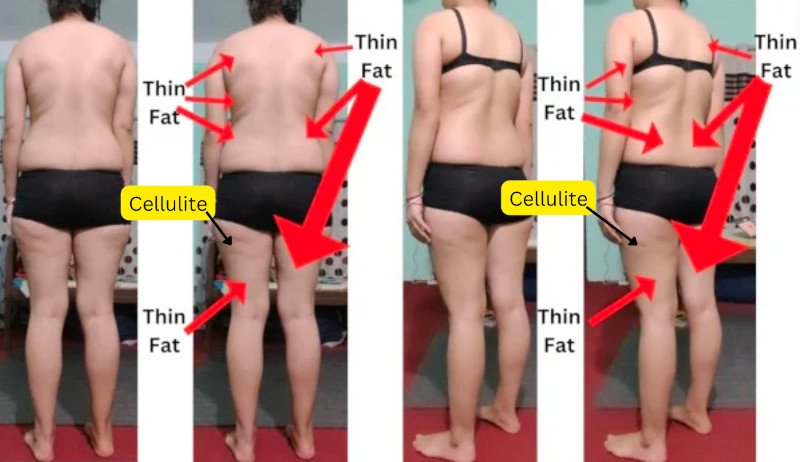
This 23-year-old research participant has a safe Standard BMI of 24.6 (two left pictures) with obvious skinny fat/normal weight obesity — lack of genetic muscle (IE thin fat & cellulite). The right two pictures are after further safe regular fat weight loss and reaching a safe Standard BMI of 21.3 — yet the skinny fat (lack of genetic muscle/thin fat and cellulite) is still obvious.
They could lose more regular fat weight down to a minimum safe BMI of 18.5, and their lacking genetic muscle tissue will not magically appear — this is 100% true no matter how low their BMI or body fat %. You cannot starve away skinny fat (lack of genetic muscle).
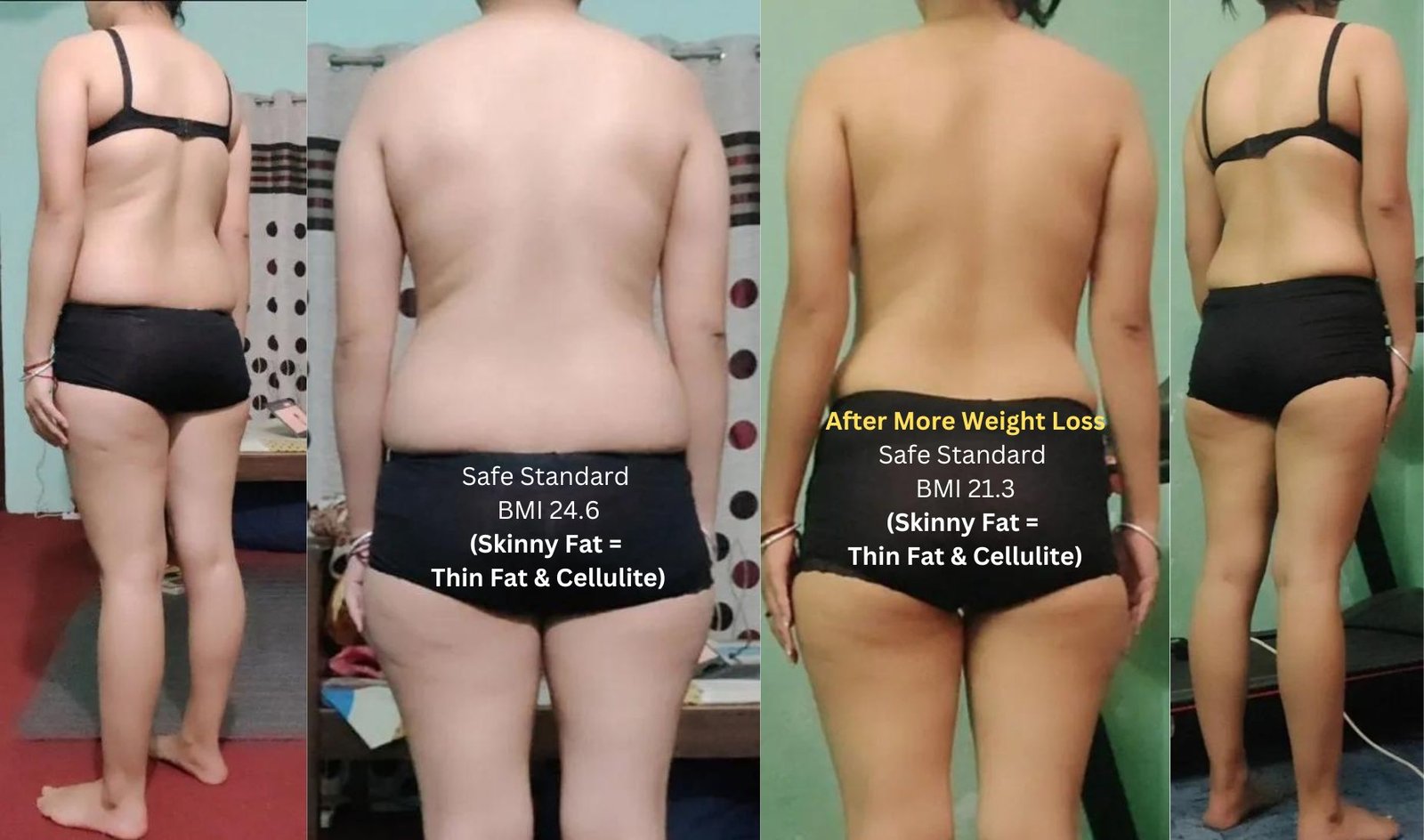
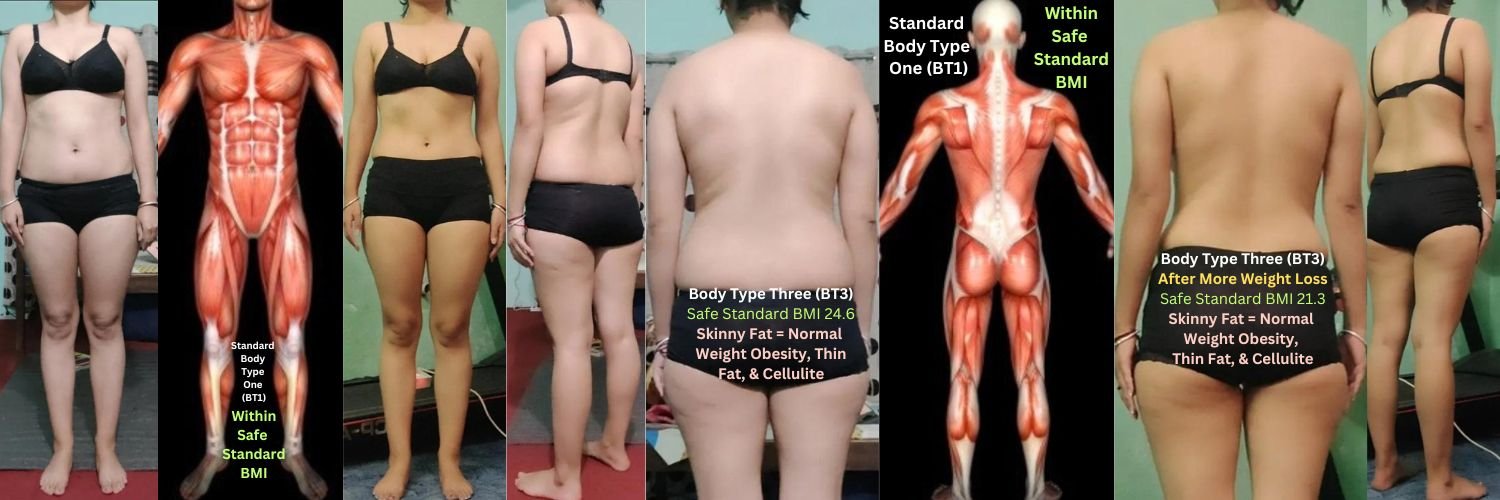
Once you are within safe Standard BMI, according to mainstream science/medicine, you are the standard human body found in any scientifically approved human body anatomy book with all 600+ muscles developed (AKA the Standard Body Type One/BT1). But it is obvious that RP 1170 is not a Standard BT1 with all 600+ muscles/mass developed. They have obvious skinny fat (lack of genetic muscle) where genetically they should have default genetic muscle/mass, but do not.
What Causes Skinny Fat?
It is an undisputed fact that muscle tissue cannot turn into any kind of fat tissue — be it regular fat, brown fat, beige fat, or skinny fat — or vice versa. This is not how human tissue works. Skinny fat (lack of genetic muscle) — thin fat and cellulite tissue — is unique tissue (our MRI Study is working on proving this). Regular fat is unique tissue. Just as muscle tissue is unique tissue.
Poor diet, exercise, and/or lifestyle can cause muscle tissue loss that can make any existing skinny fat (lack of genetic muscle) worse, but any lost muscle tissue does not magically turn into any kind of fat tissue, including skinny fat (thin fat, cellulite). This is simply not how human tissue works. Moreover, no amount of protein/nutrients/diet, exercise (cardio or resistance), or lifestyle (sleep, stress, etc.) will magically turn skinny fat (lack of genetic muscle) into muscle or get rid of, prevent, or avoid it, etc. Although the best way to reduce skinny fat is to properly add muscle mass.
For instance, Christian Bale is genetically blessed with a standard human body with all 600+ muscles developed (AKA a Standard Body Type One/BT1).
Around 2003-2004, for a movie role, he lost an insane amount of weight, including obvious muscle mass. Yet, no signs of any skinny fat (thin fat, cellulite). Genetics. If it is true that lost muscle tissue causes skinny fat, then it would apply equally and unequivocally to all human beings 100% of the time, and not just affect certain people.
Human Genetics
Thanks to genetics, 80%+ of women in the world have some degree of cellulite (skinny fat), as well as roughly 10% of men. However, 0% of them have ever permanently gotten rid of their cellulite; they can only reduce it (there is no FDA-approved way to permanently get rid of cellulite at this time). The same goes for thin fat tissue (skinny fat). All cultures, races, and genders (biological men and women) experience skinny fat (lack of genetic muscle). Skinny fat is caused by genetics and influenced by diet, exercise, and lifestyle.
If you are experiencing any type of skinny fat — particularly thin fat and/or cellulite — where genetically you should have default muscle tissue, you have had it since birth thanks to your genetics. The younger you are, the harder it is to discern skinny fat, especially thin fat.
Evolving genetic science is working on new ways to deal with skinny fat in the coming years.
How Skinny Fat Determines Genetic Scientific Body Type (Body Composition and Shape)
Scientifically identifying your unique default genetic body composition (and shape), including how much skinny fat (if any) and how severe, helps you better understand your specific metabolism, diet, exercise, and lifestyle to achieve safe, sustainable, and successful regular fat weight loss and management as well as overall health in the short and long term.
Standard Body Type One (BT1) = no skinny fat (or minimal)
Body Type Two (BT2) = slight to moderate skinny fat (lack of genetic muscle)
Body Type Three (BT3) = high-moderate to severe skinny fat (lack of genetic muscle)
Body Type Four (BT4) = very severe to extreme skinny fat (lack of genetic muscle)
The proprietary Official Scientific Body Type Quiz accurately determines your specific genetic scientific body type.
Scientific Body Type Quiz Official – Scientific Facts:
The Latest Skinny Fat Science
- Any part of the human body can be genetically underdeveloped to whatever degree, including muscles/muscle mass – with heritability estimates ranging from 30–85% for muscle strength and 50–80% for lean muscle mass. The Standard BMI, a useful guideline, fails to account for excess muscle mass (genetic or added via resistance/exercise) or any type of skinny fat. Standard Body Type One’s (BT1) have all the same 600+ muscles developed but can have different levels of genetic muscle mass, which is further influenced by height and other genetic factors, and is why not all BT1’s look or function identically.
- All human beings have all the default genetic muscle tissue they will ever have at or around birth. Some people have more genetic muscle tissue, some less. The ratio of Type 1 and Type 2 fibers varies from person to person. All this affects how much and how easily each person can add muscle mass through exercise, no less.
- Muscle tissue cannot/does not turn into any kind of fat (regular fat, skinny fat, brown fat, beige fat), or vice versa. This is not how human tissue works! Poor diet, exercise, and lifestyle can cause muscle/mass loss, but any lost muscle tissue does not magically turn into skinny fat tissue (or any kind of fat).
- Technically, you could lose 100% of your regular white/yellow fat (unique tissue) and your skinny fat (unique tissue) will remain.
- Every vertebra (cervical, thoracic, lumbar, sacrum, coccyx) houses a specific set of muscles. If any of those muscles (or related muscles) are genetically underdeveloped, to whatever degree, it directly and negatively affects body composition, shape, posture, and metabolism, no less.
- One (1) pound of muscle burns six (6) calories per day, but one (1) pound of skinny fat and/or regular fat only burns two (2) to three (3) calories daily.
- The more skinny fat and/or regular fat you have on your body, the slower/weaker your metabolism (including less glucose uptake) and the fewer calories you burn. The more muscle/mass you have, the stronger/faster your metabolism (including more glucose uptake) and the more calories you burn.
- Anywhere you have skinny fat (only subcutaneous) on your body where genetically you should have default genetic muscle/mass, the more prone you are to putting on regular fat (which can be both subcutaneous fat and visceral fat) and the harder it is to keep regular fat off (and being overweight or obese/obesity at bay) — the more skinny fat you are experiencing, the more sensitive you are to sugar and starch carbs (especially refined) and glucose (blood sugar) spikes, and the more prone you are to insulin resistance, type-2 diabetes, being overweight, and obesity.
- There are a few FDA-approved methods to reduce skinny fat, including surgery, but no amount of dieting, lifestyle, or exercise/time in the gym will permanently fix/get rid of skinny fat or turn skinny fat into muscle/mass. Diet, exercise, and lifestyle can also help you lose regular white/yellow fat and add muscle mass to reduce and manage skinny fat (lack of genetic muscle).
- You cannot permanently change/recomp your genetic body composition (no, epigenetics are not permanent), you can only temporarily change/recomposition your body through diet, lifestyle, and exercise, including weightlifting — although it is possible to maintain those changes consistently throughout your life with consistent, regular maintenance (and maybe you will tempt evolution and cause a permanent genetic mutation).
- Once you stop the resistance/exercise (like bulking and cutting weight training/lifting) that built any added muscle mass above and beyond your default genetic muscle/mass, inevitably you will gradually begin to lose that added muscle mass and eventually return to your default genetic muscle/mass levels.
- All other body types are unscientific, arbitrary, subjective nonsense — none have a scientific definiton or any science to back them up — including Kibbe, triangle, rectangle, apple, pear, hormones, etc. along with the somatotypes mesomorph, endomorph, and ectomorph body types which were fully debunked and discredited in the 1950s, 70 years ago! Although they can be roughly correlated to a genetic scientific body type.
Rough Body Type Correlations – Scientific Body Type Quiz (Official)
Hourglass (no scientific definition or research data) = genetic scientific Standard Body Type One (BT1) or Body Type Two (BT2)
Inverted Triangle (no scientific definition or research data) = genetic scientific Standard Body Type One (BT1)
Triangle (no scientific definition or research data) = genetic scientific Body Type Two (BT2) or Body Type Three (BT3)
Rectangle (no scientific definition or research data) = genetic scientific Body Type Two (BT2), Body Type Three (BT3), or Body Type Four (BT4)
Pear (no scientific definition or research data) = genetic scientific Body Type Two (BT2) or Body Type Three (BT3)
Apple (no scientific definition or research data) = genetic scientific Body Type Two (BT2), Body Type Three (BT3), or Body Type Four (BT4)
Round (no scientific definition or research data) = genetic scientific Body Type Two (BT2), Body Type Three (BT3), or Body Type Four (BT4)
Kibbe (no scientific definition or research data) = genetic scientific Standard Body Type One (BT1), Body Type Two (BT2), Body Type Three (BT3), or Body Type Four (BT4)
Hormone, Adrenal (no scientific definition or research data) = genetic scientific Standard Body Type One (BT1), Body Type Two (BT2), Body Type Three (BT3), or Body Type Four (BT4)
Hormone, Liver (no scientific definition or research data) = genetic scientific Standard Body Type One (BT1), Body Type Two (BT2), Body Type Three (BT3), or Body Type Four (BT4)
Hormone, Ovary (no scientific definition or research data) = genetic scientific Body Type Two (BT2), Body Type Three (BT3), or Body Type Four (BT4)
Hormone, Thyroid (no scientific definition or research data) = genetic scientific Body Type Two (BT2), Body Type Three (BT3), or Body Type Four (BT4)
Mesomorph (no scientific definition or research data) = genetic scientific Standard Body Type One (BT1)
Ectomorph (no scientific definition or research data) = genetic scientific Standard Body Type One (BT1) or Body Type Two (BT2)
Endomorph (no scientific definition or research data) = genetic scientific Body Type Two (BT2), Body Type Three (BT3), or Body Type Four (BT4)
View your Quiz Results privately in your private account. Each Quiz Result is a snapshot. You can take as many Quizzes as you want to track your snapshots and any body composition changes over time.
Take the Official Scientific Body Type Quiz for females and males to learn more.







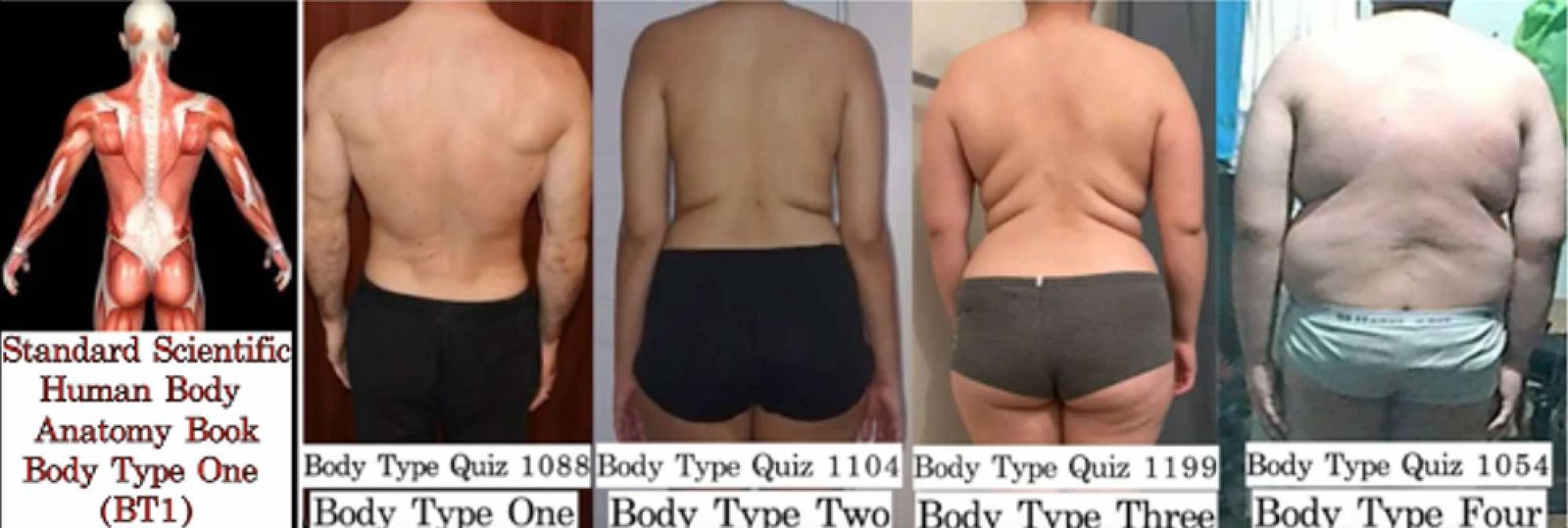






Reviews
There are no reviews yet.